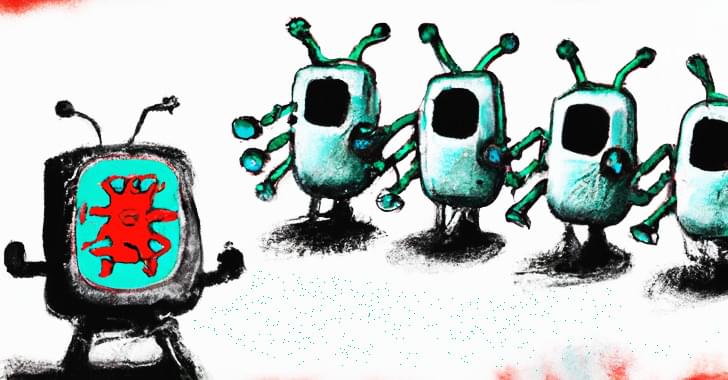Squishy robots can now heal themselves and grow as they explore.


Get a Wonderful Person Tee: https://teespring.com/stores/whatdamath.
More cool designs are on Amazon: https://amzn.to/3wDGy2i.
Alternatively, PayPal donations can be sent here: http://paypal.me/whatdamath.
Hello and welcome! My name is Anton and in this video, we will talk about a potential resolution to Fermi paradox using another — Levinthal’s Paradox.
Links:
https://theconversation.com/ai-makes-huge-progress-predictin…ent-151181
https://en.wikipedia.org/wiki/Levinthal%27s_paradox.
https://en.wikipedia.org/wiki/Protein_structure_prediction.
https://web.archive.org/web/20110523080407/http://www-miller…nthal.html.
Previous Fermi Paradox part: https://youtu.be/iCDM5uLYeJU
#fermiparadox #proteins #alienlife.
Support this channel on Patreon to help me make this a full time job:
https://www.patreon.com/whatdamath.
Bitcoin/Ethereum to spare? Donate them here to help this channel grow!
bc1qnkl3nk0zt7w0xzrgur9pnkcduj7a3xxllcn7d4
or ETH: 0x60f088B10b03115405d313f964BeA93eF0Bd3DbF
Space Engine is available for free here: http://spaceengine.org.
Enjoy and please subscribe.
Twitter: https://twitter.com/WhatDaMath.
Go to https://nordpass.com/isaacnordpass and use code isaacnordpass at the checkout to get additional 1 month for FREE!
If travel to other realities and multiverses is possible, then so is conflict between them, but how would a multiversal war be fought?
Visit our Website: http://www.isaacarthur.net.
Join Nebula: https://go.nebula.tv/isaacarthur.
Support us on Patreon: https://www.patreon.com/IsaacArthur.
Support us on Subscribestar: https://www.subscribestar.com/isaac-arthur.
Facebook Group: https://www.facebook.com/groups/1583992725237264/
Reddit: https://www.reddit.com/r/IsaacArthur/
Twitter: https://twitter.com/Isaac_A_Arthur on Twitter and RT our future content.
SFIA Discord Server: https://discord.gg/53GAShE
Listen or Download the audio of this episode from Soundcloud: Episode’s Audio-only version: https://soundcloud.com/isaac-arthur-148927746/multiverse-warfare-quantum-mania.
Episode’s Narration-only version: https://soundcloud.com/isaac-arthur-148927746/multiverse-war…ation-only.
Credits:
Multiverse Warfare and Quantum Mania.
Science & Futurism with Isaac Arthur.
Episode 382, February 16, 2023
Written, Produced & Narrated by Isaac Arthur.
Editors:
David McFarlane.
Briana Brownell.
Lukas Konecny.
Graphics:

In January 2023, the Caltech Space Solar Power Project (SSPP) is poised to launch into orbit a prototype, dubbed the Space Solar Power Demonstrator (SSPD), which will test several key components of an ambitious plan to harvest solar power in space and beam the energy back to Earth.
Space solar power provides a way to tap into the practically unlimited supply of solar energy in outer space, where the energy is constantly available without being subjected to the cycles of day and night, seasons, and cloud cover.
-I think someone may have posted it, but if not its a good read.
The launch represents the first in-situ test of the technology to harvest solar energy in space and transmit it to Earth.
Ms. Loyce Pace, MPH, is Assistant Secretary for Global Affairs (OGA), at the U.S. Department of Health and Human Services (https://www.hhs.gov/about/leadership/loyce-pace.html).
In her current role, Ms. Pace is responsible for advancing the U.S. international health agenda through multilateral and bilateral forums. Reporting directly to the Secretary of Health & Human Services (HHS), she is the Office of Global Affairs’ lead on setting priorities and policies that promote American public health agencies and interests worldwide.
Ms. Pace oversees HHS’ engagement with foreign governments and international institutions, as well policymaking bodies such as the G7, G20, United Nations General Assembly (UNGA), and World Health Assembly. Previously, she served as President & Executive Director of Global Health Council (GHC) and was also a member of the Biden-Harris Transition COVID-19 Advisory Board. At GHC, she advocated for increased federal investments in global health, in the face of budget cuts to the U.S. Centers for Disease Control & Prevention, United States Agency for International Development, and World Health Organization (WHO).
Prior to her role at GHC, Ms. Pace spent over a decade working with community-based organizations and grassroots leaders in countries across Africa and Asia on campaigns calling for person-centered access to health, including American Cancer Society, Catholic Relief Services, and the LiveStrong Foundation. Additionally, she has held positions on various global and regional advisory committees and boards that focus on equity and inclusion.
Ms. Pace holds a Bachelor’s degree with Honors in human biology from Stanford University and a Master’s degree in international health & human rights with the distinction of Delta Omega from Johns Hopkins Bloomberg School of Public Health.

Japanese “calm technology” company Mui Lab has unveiled the consumer-ready version of its Mui Board – a minimalist control hub for the smart home that looks like an unassuming block of wood.
Designed for wall mounting, the Mui Board is a plank of timber that lights up from within using a subtle white LED dot matrix display.
This can be used like a touch screen to control lighting, curtains, thermostats, speakers and other elements of the home.


A new variant of the notorious Mirai botnet has been found leveraging several security vulnerabilities to propagate itself to Linux and IoT devices.
Observed during the second half of 2022, the new version has been dubbed V3G4 by Palo Alto Networks Unit 42, which identified three different campaigns likely conducted by the same threat actor.
“Once the vulnerable devices are compromised, they will be fully controlled by attackers and become a part of the botnet,” Unit 42 researchers said. “The threat actor has the capability to utilize those devices to conduct further attacks, such as distributed denial-of-service (DDoS) attacks.”
The most popular class in the history of Yale is now available online, joining 20 other Coursera classes taught by Yale faculty.
The class, Psyc 157, “Psychology and the Good Life,” is taught by psychology professor Laurie Santos. Nearly a quarter of all Yale undergraduates have enrolled in the class in its inaugural year — a fact that attracted media attention around the globe.
Course Course.
https://www.coursera.org/learn/the-science-of-well-being.
What is course?
Start, switch, or advance your career with more than 5,400 courses, Professional Certificates, and degrees from world-class universities and companies.